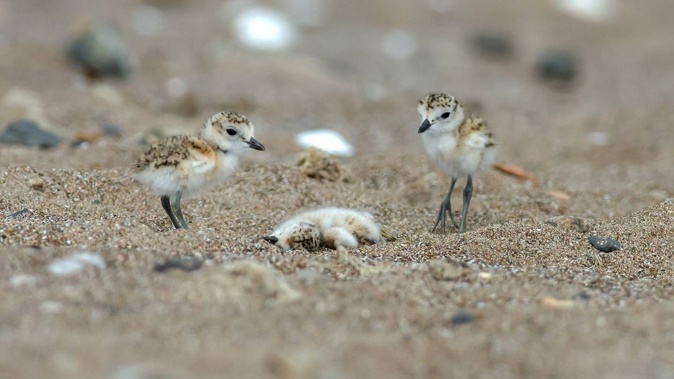
Excitement at finding three NZ dotterel eggs in a nest at Whangārei’s Sandy Bay has been tempered after one of the chicks was found dead, but locals are delighted the endangered birds are still nesting on the east coast beach.
Sandy Bay resident Dave Gould found the dotterel nest in November, and was surprised, but pleased, to see it had three eggs. Dotterel don’t nest at Sandys every year - and last year’s nest only had one egg, that happened to be washed out in the tide - so Gould was happy to see three.
Dotterels are considered endangered and in Northland they are also known to nest at Mangawhai, Waipū, Ruakākā and Te Arai Stream.
“Last year’s one got washed away, but we managed to rescue it and it ended up hatching out and being released, which was great. But to see three was pretty good. It’s a real positive.’’
Gould contacted another coast resident, Malcolm Pullman, and realising the risk to the nest - it is basically a hollow in the sand with no protection - they built up a fence around it and put up warning signs letting people know about the nest and the dangers to the eggs and subsequent chicks.
And on December 28 the eggs hatched, with all three chicks seemingly doing well.
/cloudfront-ap-southeast-2.images.arcpublishing.com/nzme/CD6XJPBJCFCMFCO2Y3RI5IULZY.JPG)
However, on Thursday morning a visit to the nest saw that one of the chicks had died. Gould said it’s unclear how it died, but there were no signs of any human or animal interaction and no footprints around the fenced-off area.
He said it may have been natural causes, and the chick may have just been the weakest one in the nest and unable to survive.
“The fence really worked though. Since we put the fence up people have been really respectful of it, and there’s no signs that anybody [killed the dotterel] so it may have just been the weak one.
/cloudfront-ap-southeast-2.images.arcpublishing.com/nzme/SXZOZTJYVZDIPDE3ANI7VEA3RQ.JPG)
“And if it had been attacked by an animal it would probably not still be there, or it would have signs of being attacked, but it doesn’t.’’
Humans and dogs were the biggest threats to dotterel nests on our beaches as the nest were often hard to spot, until you were upon them.
Gould, who has lived at Sandys since 2000, said there are some years dotterel don’t nest on the beach - estimating on average about every four years - so to have a nest with eggs two years in a row was great news, and hopefully a sign the endangered bird was on the way back. It was important that people were aware of any nests and take precautions to avoid them.
“While it wasn’t dogs involved here, the important message for people [around dotterel nests] is to be careful and keep your dogs under control, and preferably on a lead, to prevent anything bad from happening. And pay attention to, and follow, any instructions on signs around the nests.’’
/cloudfront-ap-southeast-2.images.arcpublishing.com/nzme/ZOSYBRH3IZEKHBMKQHMU2FUQQI.JPG)
The Department of Conservation (DoC) was pleased the Sandy Bay community was looking after its nesting dotterels.
“It’s wonderful to see the community taking such an active role in caring for the dotterels at Sandy Bay. It’s hard to say how the dotterel chick died, but it is reassuring to know there weren’t any predator markings around and the weather has been stable, so we can probably rule out those major threats. It is likely that the chick’s death was natural, but it’s hard to say. The remaining chicks appear to be in good health,” a DoC spokesperson said.
DoC on how you can help protect the New Zealand dotterel:
- Walk and ride your horse below the high-tide mark on beaches where dotterels are breeding.
- Please stay outside the fenced-off areas with ‘birds nesting’ signs.
- If you see a dotterel pretending to be injured, or come across eggs or chicks, please leave them alone.
- Please do not take vehicles on beaches.
- Keep your dog on a leash at all times. Remember that some beaches are only open for dog-walking at certain times. Check first with your district council
- Step lightly on the beach.
The New Zealand dotterel (Charadrius obscurus ) is a species of shorebird found only in certain areas of New Zealand. It is also called the New Zealand plover or red-breasted dotterel, and its Māori names include tūturiwhatu, pukunui, and kūkuruatu.
The southern subspecies of the New Zealand plover is considered critically endangered and was nearing extinction. There are about 2000 of the birds today.
Take your Radio, Podcasts and Music with you









